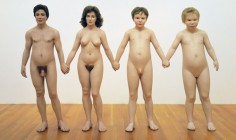CHARLES RAY
查尔斯·雷
צ’ארלס ריי
チャールズレイ
찰스 레이
Family Romance
source: momaorg
American sculptor. He studied for his BFA at the University of Iowa, Iowa City, graduating in 1975, then for his MFA at the Mason Gross School of Art, Rutgers University, NJ, graduating in 1979. Initially influenced by sculptors such as Anthony Caro, by including his own body in his works he made them more like documented performances. In Plank Piece I–II (1973; see 1994 exh. cat., p. 30), for example, he pinned his body to the wall with a large piece of wood. This literalism was manifested in another early photo work, All My Clothes (1973; Los Angeles, CA, Mus. Contemp. A.), in which he presented himself dressed in each of his outfits. By the early 1980s Ray extended this absurdity to generate a more deadpan manipulation of Minimalist iconography. In Ink Box (1986; Newport Beach, CA, Orange Co. Mus. A.), a large cube is filled to the brim with ink, giving the illusion of a solid cube. In the 1990s he used mannequins in his sculptures, for example in Family Romance (1993; E. and P. Norton, priv. col. see 1998 exh. cat., pp. 38–9), where mom, dad, brother and sister are all presented at the same height (the height of the artist), so that the nuclear family becomes a grotesque comment on the illusion of ‘normality’. Ray takes conventions, whether they are from art history or the shop window, and uses them to re-present identity and perception as coded assumptions that can be destabilized with disturbing ease by his deadpan reconfigurations.
.
.
.
.
.
source: momaorg
Two parents, two young children: “It’s a nuclear family,” as Ray says, the model of American normalcy. Yet a simple action has put everything wrong: Ray has made all of them the same height. They are also naked, and unlike the store-window mannequins they resemble, they are anatomically complete. This and the work’s title, the Freudian phrase for the suppressed erotic currents within the family unit, introduce an explicit sexuality as disturbing in this context as the protagonists’ literally equal stature.
Early works of Ray’s submitted the forms and ideas of Minimalism to the same kind of perceptual double-take that Family Romance works on the social life of middle-class Anglo-Saxon America. He has worked in photography and installation as well as sculpture, and his art has no predictable style or medium; but it often involves the surprise of the object that seems familiar yet is not. Like other works of Ray’s involving mannequins, Family Romance suggests forces of anonymity and standardization in American culture. Its manipulations of scale also imply a disruption of society’s balance of power: not only have the children grown, but the adults have shrunk.


